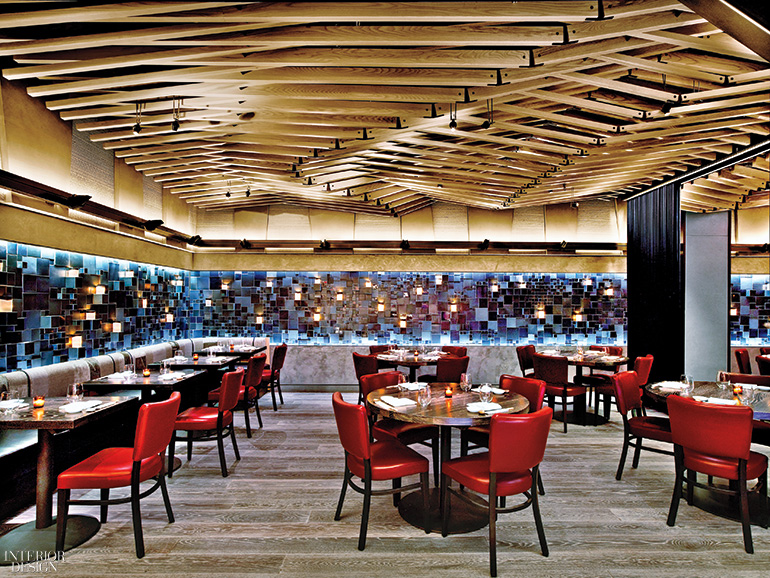If you are a design lover you will love to discover these fine dining eateries with fabulous interiors.
Auberge d’Ill by Jouin Manku


The Hôtel des Berges’ 4,250-square-foot eatery in Illhaeusern, France, is genuinely extraordinary. Patrick Jouin and Sanjit Manku finished a second redesign of the cherished gastronomic organization out of appreciation for its 50th year of Michelin triple-stardom. Jouin depicts Auberge d’Ill’s refresh as “a great moment for diners in fellowship with nature.” Reflecting pools of stainless steel are overhead, an all encompassing painting and a sparkling wall with weaved butterflies and paper songbirds decorate the walls, and cerulean and sea green/blue covering spread the floor, bringing the soul of the district’s waterway inside.
Restaurante Gastronómico by Estudihac

Gourmet expert and restauranteur César Anca came back to Madrid with Xanverí, a culinary hotspot that distinctions “the historical backdrop of Chamberí and its inception, which go back to Napoleonic times,” estudiHac imaginative chief José Manuel Ferrero says. While the primary floor houses the easygoing eating background La Desenfadada, another zone brags the more formal Restaurante Gastronómico. Restaurante Gastronómico emanates white, gold, and blue tones that imitate the shorelines of Madrid, while the seating’s blue upholstery encapsulates estudiHac’s “mature Mediterranean” design style.
Jean-Georges Restaurant by Neri & Hu Design and Research Office


Chef Jean-Georges Vongerichten got acclaimed for helping and lighting up the great French cousine. Vongerichten asked Lyndon Neri and Rosanna Hu to convey a comparative tasteful to the remodel of his 9,200-square-foot Shanghai eatery. Segments in inclination glass, encircled with metal, characterize the bar and lounge, demonstrate kitchen, and private dining areas. This was the principal refresh for the restaurant since it was first finished by Neri and Hu’s tutor, Michael Graves, in 2004. “That made it basic for us to pay tribute to the past while looking to the future,” Hu said.
Nobu Downtown by Rockwell Group


At the point when the principal Nobu opened in New York, David Rockwell made a stupendous scene for put launching chef Nobu Matsuhisha and his Japanese-Peruvian combination food. “The first eatery was of its moment,” says David Rockwell, who was entrusted with the outline of a moment area, Nobu Downtown. “This one must be, as well. We were investigating, going out on a limb, and following the lead of the nourishment.” Rockwell’s group ensured the renovation was agreeable with landmark controls and honored Nobu conventions. “We pulled from specific bits of the DNA, like the river rocks,” studio leader Greg Keffer says.
Saltz by Rolf Sachs


Rolf Sachs, in partnership with local studio Küchel Architects, designed the five-star hotel restaurant Saltz as a tribute to the Swiss Alps, which is particularly fitting considering the 3,000-square-foot restaurant is located inside Zurich’s Dolder Grand—a hotel with a spectacular view of the montains. Beneath wide oak floor planks, the roof features criss-crossed red mountaineer rope, while a wall boasts a neon fixture that outlines the 182 mountain peaks visible from the restaurant’s rooftop.
Plant Food + Wine by Rene Gonzalez Architect


Karla Dascal entrusted Rene Gonzalez to expand her business headquarters into Sacred Space Miami, transforming the storage area of the former warehouse into a second location for chef Matthew Kenney’s Plant Food + Wine restaurant. Gonzalez aimed to create a “a seamless interface between indoor and outdoor,” made possible by glass panels that fold away to remove the venue’s front wall. Gonzalez focused on how to accommodate both casual and formal at the same time, where a group of coworkers toting laptops or a solo guest reading a magazine can all feel at home.


Chef Albert Adrià wanted “something very unique, different from all the restaurants around” for his latest restaurant. Enigma, part of his El Barri project, is a 6,000-square-foot experimental futuristic production by Rafael Aranda, Carme Pigem, and Ramon Villa. Up to 28 patrons a night embark on a cousine journey of 40-plus plates from seven different stations, including an aperitif bar and a teppanyaki grill. Diners are infused in a bluish-green world that is organic and technologic, where transparent resin barrel chairs and pedestal tables show up to have been chiseled from ice caves.












